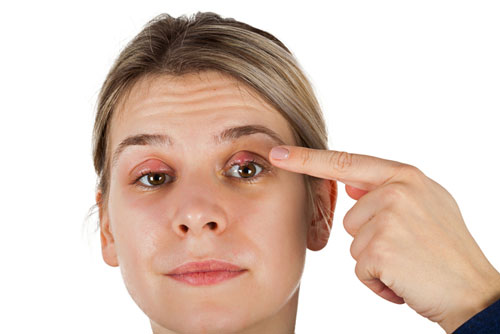When the coronavirus outbreak began, we were told that a fever and cough were the two main signs that you were infected.
But as the pandemic continued, doctors began reporting other symptoms that seemed surprising. Some patients had toe lesions. Others lost their sense of smell. Seniors often had mental issues.
Now, as the U.S. tops 1.5 million COVID-19 cases, doctors are discovering even more symptoms that had not been previously associated with the illness.
Here are seven surprising signs of COVID-19.
7 Little-Known Coronavirus Signs
- Multi-system inflammatory syndrome (MSIS). Initially, it looked like the coronavirus had little effect on children. But now doctors in New York State believe it’s linked to this condition in kids. There are similar reports in Europe.[1]
Symptoms of MSIS include fever combined with rashes, stomach aches, diarrhea, and vomiting.[2] - A rash. The coronavirus can cause a hive-like rash call paraviral dermatosis. It looks like small red dots or purplish discolorations. They are usually on the legs or stomach.
The rash is caused by the body’s immune response to the virus, which triggers superficial blood-vessel damage under the skin.[3] - Hand numbness. The virus may cause Guillain-Barre syndrome, a nervous system disorder. It is triggered by immune responses to virus infections. Patients may feel a prickling or burning sensation in the hands.
Other symptoms include poor coordination, muscle weakness, and temporary paralysis. - Red, puffy eyes. This is sometimes called pink eye. It results when the virus infects the conjunctiva. That’s the tissue lining the inside of the eyelids. It also covers the white of the eye.
One study found that a third of patients hospitalized with COVID-19 had this symptom.[4] - Blood clots and strokes. Doctors worldwide have noticed a link between COVID-19 and blood clots. They often occur in younger patients who are normally at low risk for clotting. An article published in the New England Journal of Medicine described five patients between the ages of 33 and 49. They had COVID-19 and were admitted to the hospital suffering severe strokes.[5]
A study published in the journal Thrombotic Research found 31% of COVID-19 patients in Dutch intensive care units had blood clots.[6]
Dr. Maxine Dexter is a pulmonary and critical care specialist at Kaiser Permanente. She said clotting “seems to be a significant issue.”[7] - Digestive issues. A study published in the journal Gastroenterology showed 32% of COVID-19 patients had stomach problems. Symptoms included nausea, diminished appetite, and diarrhea. Doctors have found that coronavirus binds to ACE2 receptors in the lungs. These receptors are abundant in the digestive system as well.[8]
A review published in Stanford Medicine had nearly identical findings. Almost a third of 116 COVID-19 patients had stomach symptoms.[9] - Happy hypoxia. Hypoxia is lack of oxygen. The coronavirus causes this condition with pneumonia and inflammation. Your lungs can’t adequately do their job of absorbing oxygen and expelling carbon dioxide.
Normally, people with hypoxia feel terrible. They have labored breathing. They may have chest pain. And if their blood oxygen level gets low enough, they pass out or die.
But COVID-19 patients can have extremely low blood-oxygen levels with no outward problems. Not only do they not lose consciousness, but they chat with people, scroll through their phones, and say they feel fine. Doctors call it “happy hypoxia.”
Dr. Reuben Strayer is an emergency physician in New York City. He said there is “a mismatch (between) what we see on the monitor and what the patient looks like in front of us.” [10]
Happy hypoxia can cause patients to delay getting treatment. By the time they see a doctor, it may be too late to save them.
Dr. Elnara Marcia Negri is a pulmonologist at Hospital Sírio-Libanês in São Paulo, Brazil. She recommends people get an oximeter. It’s a small device you clip on your finger. It reads your oxygen level. Dr. Negri tells patients to go to the hospital if their blood oxygen saturation is below 94%.[11]
Oximeters are available from online retailers and some drugstores.
If you have any of these symptoms—even if you don’t have the more common signs of COVID-19—call your doctor.
Editor’s Note: Discover the single best supplement for stronger immunity… The fruit extract that helps 93% of people with respiratory viruses get better in just two days… The germ hotspot that most of us forget to sanitize. Find all this and more in Independent Healing’s Coronavirus Pandemic Guide. Go HERE.
Related Articles
Coronavirus Stress: 5 Ways to Keep Calm and Carry On
9 Coronavirus Symptoms You Should Watch For
Coronavirus: Seniors Are
Showing Odd Symptoms
Like this Article? Forward this article here or Share on Facebook.
[1]https://www.nytimes.com/2020/05/13/health/coronavirus-children-kawasaki-pmis.html
[2]https://www.the-scientist.com/news-opinion/the-unusual-symptoms-of-covid-19-67522
[3] https://www.bloomberg.com/news/features/2020-05-11/all-the-covid-19-symptoms-you-didn-t-know-about
[4] https://www.contagionlive.com/news/the-eyes-have-it-novel-coronavirus-in-eye-can-be-communicable
[5]https://www.nejm.org/doi/full/10.1056/NEJMc2009787
[6]https://www.ncbi.nlm.nih.gov/pmc/articles/PMC7146714/
[7]https://www.healthline.com/health-news/the-covid-19-symptoms-most-people-could-miss#Cardiovascular-complications
[8]https://www.gastrojournal.org/article/S0016-5085(20)30471-6/fulltext
[9]http://med.stanford.edu/news/all-news/2020/04/stomach-complaints-common-in-covid-19-patients.html
[10]https://science.sciencemag.org/content/368/6490/455
[11]https://science.sciencemag.org/content/368/6490/455

